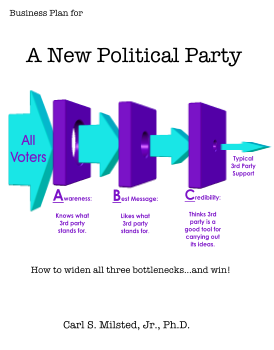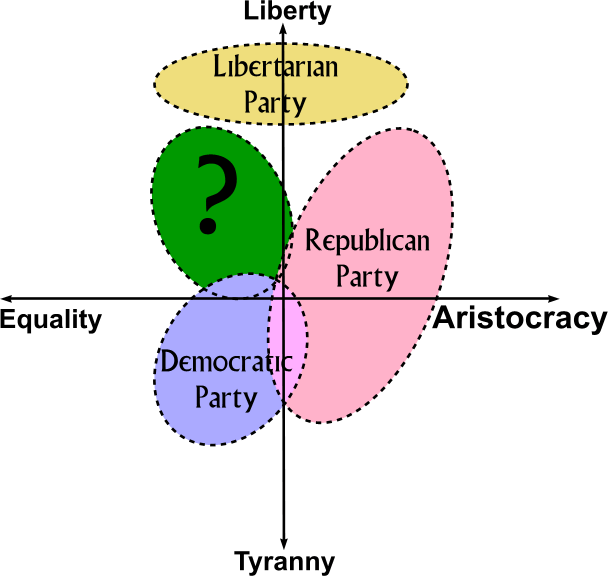The Real Sweet Spot
The year was 2002 (thereabouts). The day and the city were beautiful. City-County plaza was a small collection of artistic small skyscrapers built in the 1920s. In front was a lawn, suitable for civic events. Lying placidly on the lawn were assorted groups of hippies, smoking their favorite herb. Before them played assorted mediocre bands, singing the praises of said herb. Between songs, legalization advocates took to the microphone. Such was the Hempstock Festival, Asheville, North Carolina.
Into this environ this author went about, voter registration forms in hand, attempting to find new Libertarians. Keep in mind that this was North Carolina, a very difficult ballot access state. The Libertarian Party was the only third party on the ballot. We were the Party of Pot. This was a pot legalization rally.
No takers.
I got plenty of people to register to vote, but none would check the “Libertarian” box. Many wanted to register as Green. When told this was not an option, they chose Unaffiliated. When asked why, they voiced concern over corporate power, concentration of wealth, and the environment.
They agreed with the LP on social issues, and on peace issues, but that was not enough. Such positioning wins few hearts.
Why take the heat for being in favor of drug legalization when the druggies won’t support you?
And is it politically viable to focus on the social issues in order to win the Left? Perhaps the LP slogan could be, “Yes, we favor drugs and prostitution, but at least we’re unpatriotic.”
That evening, I had an epiphany. I realized that the LP needed to do something different in order to win the hearts of the libertarian-leaning Left.
“I’m worried about big corporations and the environment.”
Or, as Bill Clinton said, “It’s the economy, stupid.”
Economic issues trump social issues.
“Big corporations, the rich, the environment…”
I finally listened. They didn’t say “I want more government programs.” They didn’t say, “I want more government control of the economy.” Those are but proposed solutions by the social democrats. The stated values were economic equality and a cleaner environment.
The Nolan Chart does an excellent job of describing conservatism, and the difference between conservatism and libertarianism. It does a much poorer job of describing liberals. In fact, the Nolan Chart is not really two-dimensional. Both dimensions are different aspects of a value of concern to libertarians: the amount of government. It says little about what government should do with its power in the various domains.
Once upon a time it was the Left that called for smaller government. The classical liberals were liberals. Even Murray Rothbard understood this—mostly.
Listen to the Left. What do they think of themselves? What do they accuse the Right of being?
�
This is the way the Left views the Left-Right spectrum. It is also the way the mainstream generally views the spectrum. It is historically correct as well; the original Right sat on the right of the king. Size of government has nothing to do with this spectrum. For that, we need another axis.
�
The amount of government is a separate issue from egalitarianism vs. elitism. Locally, at least, the two axes can be treated as orthogonal.
Globally, there is coupling. There are some combinations of freedom/equality or lack thereof that are impossible to attain. Put too much power in a big central government and you create an environment for inequality as the Stalin regime proved. It’s good to be the king—or commissar. Even the more successful attempts at complete equality lead to constraints, as anyone who has lived in a commune has experienced. Such constraints can be by the group as a whole, vs. a leader, but it is constraint nonetheless.
Meanwhile, the condition of maximal liberty is also at odds with a large wealth gap! The greater the wealth gap, the greater the calls for socialism. Small government with a large wealth gap requires constraints on the democratic process (which the U.S. had in the past through such mechanisms as property requirements and poll taxes). And with such restraints on democracy, you have a pull towards police state conditions from the rich, in order to protect such wealth from the envious masses. Such was Europe before the modern era. The U.S. had elements of such as well. Prison conditions have been brutal throughout much of U.S. history, despite the existence of the Bill of Rights. Throw in the conditions on the slave ships and treatment of the Indians and the Bush Administration doesn’t look so bad by comparison.
Methinks that conditions for minimal government/maximal liberty are somewhere to the left of our current economic situation. Despite this, many libertarians place themselves on the right, economically. The result is political failure.
Look at the upper left quadrant on the chart above. The area close to the center (the U.S. status quo) is nearly empty. There is a market niche waiting to be filled. And until that niche is filled, the U.S. will continue to move towards bigger government and a bigger gap between rich and poor.
The Libertarian Party could move down and to the left and fill this niche.
Or, the Green Party could move up and a tad to the right and fill this niche. Ecology and economics are similar disciplines. They borrow from each other. Darwin drew much inspiration from Adam Smith, and many modern economists draw much inspiration from nature. Free market economics and efficiency go hand in hand. It is possible to put together a very green small government agenda by getting the government to tax certain externalities, get rid of various wasteful subsidies, and then step back and let the market do its thing.
Similarly, libertarians could create a very lefty agenda by getting rid of the many subsidies for investors (deficit spending, the Social Security payroll tax, etc.), corporate executives (restrictions on the capital market which squeeze smalltime entrepreneurs), and natural resource hoarders/exploiters (implement Henry George’s tax theories). Many libertarians end up on the Right because they overlook the differences between land (and other natural resources) and capital. A more complete view of economics and natural rights moves a libertarian to the left, with a generous dollop of environmentalism thrown in.
I have already done focus group testing. A program of smaller government coupled with a smaller wealth gap is very appealing. It passes the friends and family test. It passes the stranger test. There is a huge market; it thus passes Rule 1. Such a party could also pass Rule 2; while we are talking about two or more values, we still have a definition for our new party. We also pass Rule 3, since the upper left agenda is equally different from both the Democratic and Republican agendas. Finally, the hardcore activists running the major parties do not like the upper-left agenda. We can expect to continue to pass Rule 3; we need not worry about a major party stealing our agenda.
The upper-left market is potentially bigger than either the Democratic or Republican markets! It isn’t there yet; most voters don’t even realize that such an agenda is possible. But once informed, there is great interest. It is simply a matter of voter education. (Not voter indoctrination. There is a difference, as I will cover in Part IV.) The situation is similar to the introduction of movies or radio. There was no great demand for such products at first, because people didn’t know such were possible. But once introduced to the market, these products were incredibly popular.
The question is which party will seize the opportunity: Libertarian? Green? Free State? Constitution?
Or do I have to start a new party?
Previous
| 1
| 2
| 3
| 4
| 5
| 6 | 7
| 8
| Next
Copyright 2007, Carl S. Milsted, Jr. All rights reserved.
|








